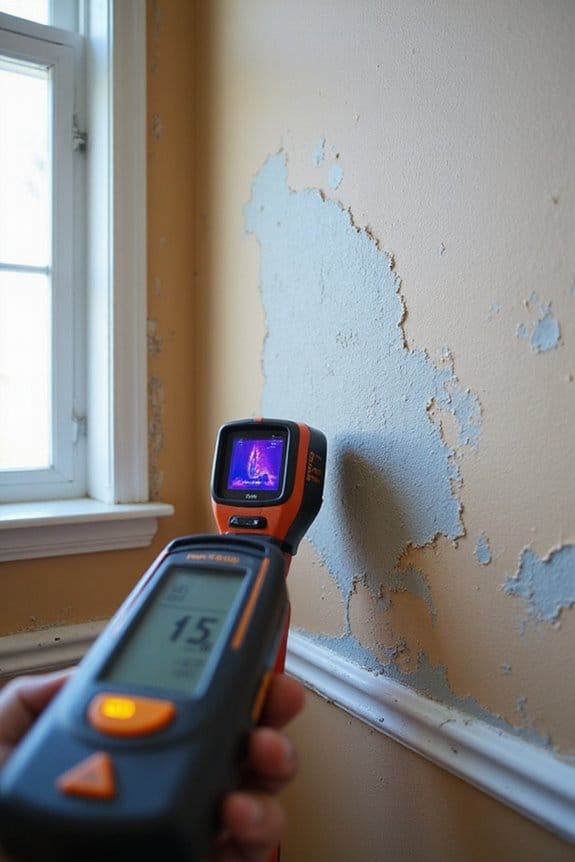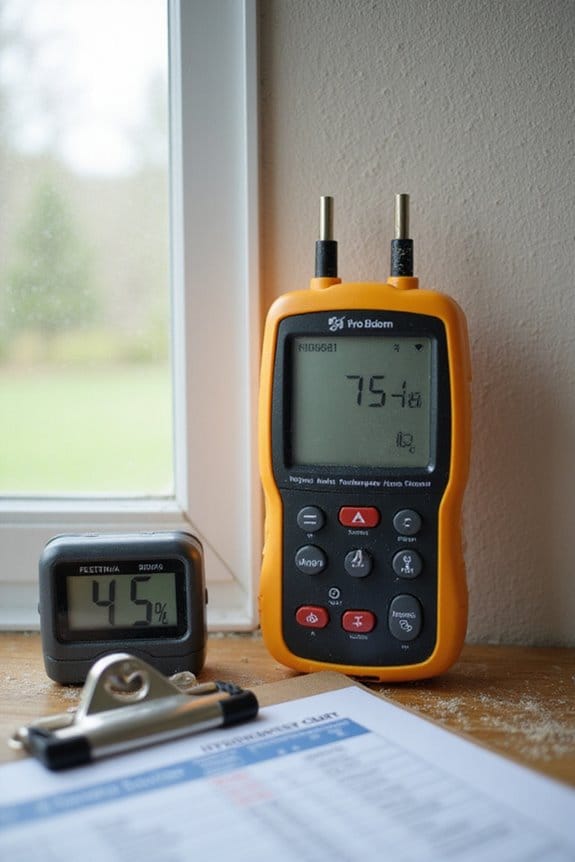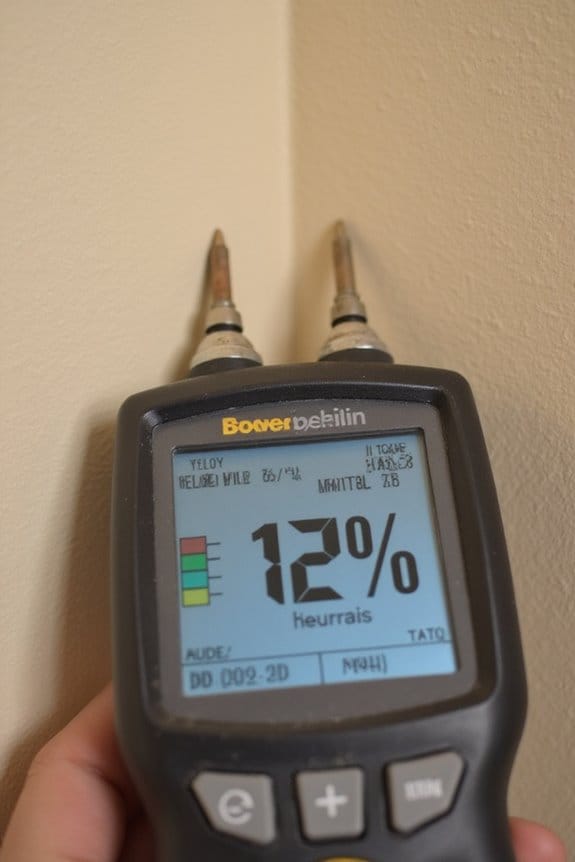A normal moisture reading on walls, especially drywall, usually falls between 5% to 12%. If you find readings around 12% to 17%, it’s still fixable, but you might want a pro to check it out. Anything above 17%? Yikes! That often means it’s time for replacement. Remember, higher humidity can skew these numbers, so always check a few spots. Stick around, and I’ll share more about what to look for and how to keep those pesky moisture levels in check!
Key Takeaways
- A normal moisture reading for drywall is between 5% to 12%, indicating it is in good condition.
- Readings between 12% to 17% may require professional assessment but can still be salvageable.
- Moisture levels above 17% typically indicate that drywall replacement is necessary.
- Ambient humidity and temperature can influence moisture readings, so consider these factors.
- Regular calibration of moisture meters is crucial to ensure accurate measurements.
Understanding Moisture Readings in Walls

When you’re checking for moisture in walls, it’s important to know what those numbers really mean—after all, nobody wants a surprise damp patch lurking behind the paint! Here’s how to understand moisture readings:
- Know Your Meter: Use a moisture meter calibrated for the specific material you’re testing. Wood meters aren’t your friends here!
- Moisture Distribution: Check multiple spots across the wall. This helps identify where moisture is concentrated.
- Environmental Context: Remember that temperature and humidity can skew your readings. Always consider these factors.
- Avoid Overreacting: A high reading on plaster might not signal trouble. Calibration techniques come into play here, so don’t panic just yet! Regularly calibrating devices can help ensure measurement accuracy and range for better assessment.
With these tips, you’ll be better equipped to tackle any moisture issues without losing your cool.
Acceptable Moisture Levels for Drywall

Understanding moisture readings is just the tip of the iceberg. When it comes to drywall, knowing the acceptable moisture levels is essential for maintaining its integrity. Here’s a quick breakdown:
- 5% to 12%: This is the sweet spot; your drywall’s in good shape.
- 12% to 17%: It might still be salvageable, but get a pro to check it out.
- Above 17%: Time to say goodbye! This moisture threshold usually means replacement is necessary.
Keep in mind, ambient humidity can affect these readings. If you see moisture creeping up, act fast! Elevations can lead to issues like mold, which no one wants. So, grab that moisture meter and let’s keep our walls happy! Additionally, moisture meters can help you quickly assess the moisture levels in various materials, ensuring that you’re making informed decisions about your home’s maintenance.
Indicators of Dampness in Walls

Indicators of Dampness in Walls
Dampness in walls can be a sneaky little problem that often goes unnoticed until it’s too late. I’ve learned to keep an eye out for some key indicators. Here are a few visual signs and sensory cues that scream “dampness”:
- Discoloration or stains on walls often mean moisture’s at work.
- Peeling or bubbling paint? That’s a cry for help.
- Cold walls could indicate excess moisture lurking inside.
- Musty smells in a room? Yikes, that’s a red flag!
- Look for efflorescence, the white powdery residue from evaporating moisture.
If you notice these signs, it’s time to investigate further. Ignoring them might lead to bigger issues down the line. Trust me, you don’t want that! Regular monitoring with a moisture meter can help detect hidden moisture problems before they escalate.
The Role of Humidity in Moisture Content

Humidity plays an essential role in the moisture content of walls, and I’m here to break it down for you.
- Humidity Fluctuations: When outdoor or indoor humidity rises, walls naturally absorb moisture. This can push readings above the normal range.
- Material Matters: Wall materials like drywall and brick are hygroscopic, meaning they absorb moisture based on the surrounding humidity.
- Seasonal Changes: In spring and summer, higher humidity can elevate moisture readings, while winter often reduces them.
To keep moisture levels in check, I recommend using exhaust fans and dehumidifiers. Maintaining indoor humidity between 30% and 50% is key. It’s like giving your walls a drink, but not too much—otherwise, you might end up with some unexpected roommates, like mold! Regularly using a pinless moisture meter can help monitor these levels effectively.
Measuring Moisture With Meters

When it comes to keeping an eye on moisture levels in your walls, moisture meters are your best friends. I recommend using high-quality moisture meters for their reading accuracy, often within 0.1%. There are two main types:
- Pin-type: These invasive meters show moisture content as a percentage.
- Pinless: Non-invasive meters provide comparative scale readings.
Make sure to check multiple spots for a reliable moisture profile. And don’t forget about moisture meter calibration; it’s essential for trustworthy results. Ideal moisture readings for walls range from 5% to 12%, while anything above 16% suggests you may need to dig deeper. Remember, monitoring moisture is vital to prevent mold and structural issues. So, grab that meter and get measuring! Additionally, using a moisture meter with nine calibration scales can enhance your accuracy across different materials.
Common Causes of Excess Moisture in Walls
Moisture issues in walls can sneak up on you, often stemming from various common sources that you might not even consider. Here are some culprits to watch for:
- Capillary Action: Moisture can rise through masonry walls when barriers fail. This sneaky moisture travels through tiny channels in porous concrete.
- Plumbing Defects: Leaky pipes or appliances can lead to unwanted water seepage. Keep an eye on those joints—they can be sneaky!
- Poor Ventilation: If your home isn’t breathing, trapped moisture can cause condensation, especially in kitchens and bathrooms.
- External Water Sources: Rainwater or standing water near your foundation can find its way into walls, causing issues.
Staying proactive with maintenance can go a long way in keeping your walls dry!
Consequences of High Moisture Levels
High moisture levels in your home can lead to several serious consequences that you might not immediately notice. Here are some key issues to watch out for:
- Structural Integrity: Prolonged moisture can damage foundations, causing cracks. These cracks allow even more moisture in, creating a vicious cycle that weakens your home.
- Aesthetic Damage: Damp walls can lead to unsightly stains, peeling paint, and even algae growth outside. It’s like your house is wearing a sad, moldy sweater!
- Energy Costs: High moisture makes it tougher to heat your home, driving up those utility bills.
- Material Damage: Wood can warp or rot, while metal components might corrode.
Keeping an eye on moisture levels can save you from a lot of headaches—and expenses!
Mold Growth Risks Associated With Moisture
Although many homeowners don’t realize it, even small amounts of moisture can lead to significant mold growth risks. Here’s what you need to know:
- Humidity Levels: Mold thrives in areas with over 55% humidity. Keep it below that!
- Wall Moisture: If the moisture content in your walls exceeds 16%, you’re inviting trouble. Aim to keep it below 20%.
- Ventilation: Proper airflow in bathrooms and kitchens is essential. It prevents localized humidity and mold buildup.
Using effective mold prevention strategies and moisture management techniques can save you headaches. Regularly check for leaks and repair them promptly. Remember, a little prevention goes a long way, and it’s much easier than dealing with mold later! Stay vigilant, and your home will thank you.
Importance of Timely Remediation
When you notice water damage, acting quickly can make all the difference. Timely intervention is essential for effective moisture management. Here’s why:
- Prevent Further Damage: Quick action stops water from causing structural issues like wood rot or drywall deterioration.
- Health Risks: Fast moisture control keeps mold and mildew at bay, reducing health problems like asthma and allergies.
- Preserve Property Value: Early remediation protects your belongings and maintains your property’s worth.
- Lower Repair Costs: Acting fast limits damage, leading to less expensive repairs and shorter drying times.
- Boost Restoration Success: Using moisture control devices promptly guarantees thorough drying and better long-term results.
Professional Inspection and Testing Methods
To guarantee your walls remain in good condition, understanding professional inspection and testing methods is essential. Here are a few key techniques I recommend:
- Electronic Moisture Meters: These handy tools measure resistance to electrical current, helping to pinpoint moisture levels accurately. Pin-type meters probe the wall, while pinless versions offer non-invasive options.
- Plastic Sheet Method: A simple, cost-effective way to detect moisture. Just seal a plastic sheet over a surface and check for condensation after 16 hours.
- Thermal Imaging: This tech-savvy method uses cameras to find cooler areas that might indicate moisture.
- Gravimetric Analysis: The gold standard for accuracy, this involves drilling core samples to measure moisture content precisely.
Using these diagnostic tools can really help keep your walls healthy!
Frequently Asked Questions
How Often Should I Check Moisture Levels in My Walls?
Like a vigilant gardener, I check my walls annually for moisture signs. I monitor during humid months and more often in water-prone areas—consistent moisture reading frequency helps prevent unseen damage and maintain a healthy home.
Can Seasonal Changes Affect Moisture Readings in Walls?
Absolutely, I’ve noticed that seasonal humidity and temperature fluctuations considerably affect moisture readings in walls. Higher humidity months often lead to increased readings, while drier seasons can show lower levels. It’s crucial to monitor these changes.
What Tools Can Homeowners Use to Measure Wall Moisture?
When I measure wall moisture, I rely on moisture meters for precise readings and infrared thermometers to spot temperature differences. These tools help me effectively monitor and manage moisture levels in my home.
Are There Specific Wall Materials More Prone to Moisture Issues?
Yes, I’ve noticed that drywall susceptibility is quite high, often leading to mold if moisture exceeds certain levels. Brick moisture can be problematic too, especially if proper drainage isn’t maintained. Both materials need careful monitoring.
How Can I Improve Ventilation to Reduce Wall Moisture?
To improve ventilation and reduce wall moisture, I’ve installed ventilation systems and regularly use exhaust fans. Enhancing air circulation with fans and opening windows helps keep humidity levels down, creating a healthier indoor environment.







